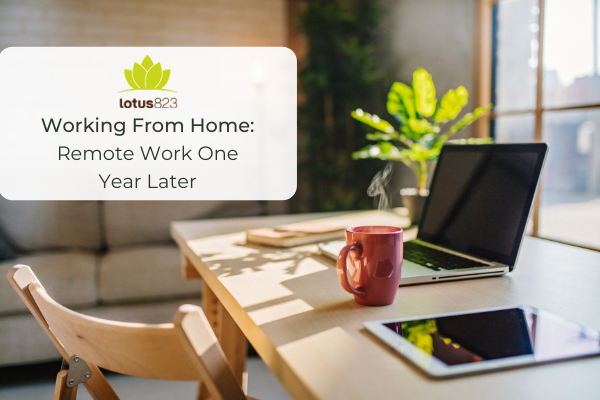
This month marks the first anniversary of the COVID-19 pandemic forcing the U.S. into shutdown and, in turn, the abrupt closure of offices and workplaces. At first, many believed the shutdowns would last from weeks to months, however, the pandemic ushered a new era of remote work for millions of employed Americans. In fact, 71% of U.S.-based workers are still currently working from home. Over the last 12 months, we’ve learned many lessons about working remotely, maintaining a work-life balance, and more. Read on for our WFH reflection – one year into the pandemic!
How it Began
On March 11th, 2020, the World Health Organization declared the coronavirus outbreak a pandemic. In just a few days, companies around the world shut their office doors and many had little time to prepare their employees for working from home. From the start, companies were focused on marking sure workers were well-equipped with a home office by allowing things like tech equipment, laptops, and more to be expensed or taken home.
Adapting To a New Normal
As David and Allison Hernandez, lotus823’s Co-Founders and Managing Partners always say, “our people are our greatest resource.” With this in mind, lotus823 deployed the business management software, 15Five, which focuses on celebrating each others’ wins through “high-fives” and short messages to show appreciation. It was of great importance to maintain the same level of culture and appreciation of employees while working from home.
While many companies are embracing more temporary work-from-home solutions, others plan to let much of their staff work from home permanently. Facebook’s Mark Zuckerberg stated that half of their employees could be working remotely within the next five to 10 years. This change comes as an effort to satisfy employees’ new-found desire to work from home and allow for a more diverse employee base, in which those from different cities, backgrounds, and perspectives can work for Facebook without having to relocate.
In addition, Twitter is allowing its workforce to have a remote work option forever. Other companies like Square, Shopify, Slack, Box, and more are offering a “work from anywhere” policy and are stepping away from the traditional office-only work environment.
Impacts on Marketing Businesses
There are many conversations surrounding the changing work environment, however, there haven’t been nearly as many about how these changes are affecting consumer behavior and how marketers need to adapt their strategies. For one, people are not physically commuting to and from work nearly as much as they were a year ago. Marketers used to base some of their strategies upon knowing when their consumers were traveling, knowing they’d be in their car, on a train, or a bus. But now, the commute to work is from one’s bed to their desk.
With more time to spare, a lot more people are active on social media during the day. As of March 2020, social media users in the U.S. were staying online more, spending at least an additional 1-2 hours online per day. Marketers can take this opportunity to put more social media content out for a brand, or pivot their email campaign messaging to acknowledge working-from-home. Similarly, consumers are turning to the digital world to fill the void of social interaction that the pandemic left. Companies can leverage this desire for social interaction by creating more interactive contests, virtual networking events, and more.
Lastly, consumers have become comfortable with making almost all of their purchases online. A study conducted by PYMNTS found that 35.7 percent of U.S. consumers are now buying retail goods online as of May 23, compared to 29.2 percent who did so in April. Online sellers of household goods and groceries are seeing the biggest uptick in sales as consumers avoid brick-and-mortar stores. For digital marketers and advertisers, specifically for online grocers, this provides the opportunity to shift even more business online. With such a sudden shift, it’s truly up to marketers to evolve and meet the changing needs of consumers who are more present online than ever before.
Key Takeaways
Evolving Technology from the Office to Home
With the help of online platforms like Zoom, WebEx, and more, businesses are able to hold meetings and conduct communication with employees and clients. Google Meet, Google’s video chat service, saw an increase of 2 million users per day at the start of the pandemic. In May, Washington Post reported that webcams were selling out or were on weeks-long backorder everywhere. Although transitioning into remote work was difficult for many businesses, one year later most have a dependable routine and access to reliable work-from-home technology. A
Strong Culture of Collaboration and Connectivity is Key
The center of a successful business is now the ability to communicate and collaborate with team members, despite any difficulties virtual work presents. Here are some ways companies are maintaining a strong culture and workforce bond while working remotely:
- Company happy hours: some businesses are using Google Meet or Zoom to gather virtually and play trivia games with incentives
- Coffee breaks: Management or leadership can set up individual coffee meet-ups virtually for employees to catch up and talk about things outside of work
- Virtual home office hours: Some employees can set aside time for others to call them and ask them questions about assignments or go over projects
- Questions of the Week: Once a week, an assigned employee can ask a fun question for the workforce to answer. This helps to bond your employees and take some time to learn about each other outside of work-related things!
Work-life Balance is More Important Now Than Ever Before
Without the separation of office life and home life, employees and managers need to set boundaries on their working schedule as well as take enough downtime to prioritize their wellbeing. Reports have shown a 47% increase in productivity over the past year, however, there needs to be a balance between working and living at home in order to maintain this. Having more hours available to work may be great in the beginning, but this may lead employees to burn out. It’s best that employees try to work within their set hours, take small breaks often, and plan activities after work that allow for some relaxation.
While the first anniversary of the pandemic and working from home isn’t something that businesses necessarily want to celebrate, it is important to reflect on how well many businesses have handled such a swift transition. This transition will likely continue to a more online world and remote work. Now, it’s up to marketers and businesses to continue to evolve and meet the changing needs of consumers and employees as work and home lives overlap.








